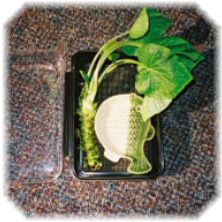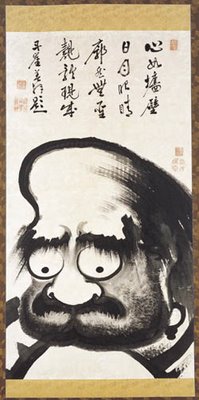:::::::::::::::::::::::::::::::::::::::::::::::::::::::::::::::::::::::::::::::::::::::::::::::::::::::
Daruma Yobanashi だるま夜話
Daruma Story for a Spooky Night
Yobanashi are stories told in hot summer nights, especially in August, to make people shiver and feel cool.
It was part of the culture of Old Edo (大江戸).
. - - - Welcome to Edo 江戸 ! .

Edo Haiku Yobanashi 江戸俳句夜話
kigo for all summer
yobanashi 夜話 "night story"
tatebanko 立版古 (たてばんこ) cut-out diorama paintings
okoshi-e 起し絵(おこしえ)
kumiage, kumi-age 組上(くみあげ)
kimitate tooroo 組立燈籠(くみたてとうろう)
They were cut out from hard paper and placed near the window at night, with a candle or small light bulb (in the early Meiji-period), so that children could see them from outside.
. tatebanko diorama and Daruma
:::::::::::::::::::::::::::::::::::::::::::::::::::::::::::::::::::::::::::::::::::::::::::::::::::::

photo - minwaza みんわ座
One of these stories involves our Daruma san.
The Story
Daruma painted on a hanging scroll, looks lifeless into a room. The lady of the home goes to bed early, because her husband is out drinking. She leaves a flask of ricewine and a cup on the table for him, just in case.

When she leaves the room, the Daruma from the scroll suddenly rolls over, into the room and starts drinking the flask of ricewine. When he gets drunk he begins to dance around the room, using wooden clappers to keep the rythm. He suddenly has arms and legs coming out of his round red body here and there. He makes a lot of noise so the lady of the house wakes up.
When she enters the room, Daruma makes a sudden retreat into his hanging scroll, but in the haste he hangs in there now showing his backside, no face. The lady looks at the changed scroll and shakes in wonder.

source : Minwaza みんわ座
The End.
- quote

A man is hanging a scroll of a daruma doll on his wall, which he had found at an antique shop. He’s very pleased with this scroll on his wall. It’s the Sumida River Fireworks festival today and you could hear the fireworks going off in the background. After the man leaves the house to go enjoy the fireworks, the daruma doll pops out from the scroll and starts drinking the sake that the man had been drinking before he left the house. After a few drinks, the doll starts dancing and partying. Then we hear a voice from the next room asking, “Who’s there? Who’s making that noise?” The doll looks to find the man’s wife lying in a futon and ...
This was a very popular comedy play during the tumultuous, end-of-Edo period.
- source : www.jpf.go.jp/e
The Night Story Telling (yobanashi) was accompanied by a kind a band of shamisen, flute and drums, making eery noises.
It was often done combined with a kind of slide show (utsushi-e 写し絵, kage-e 影絵人形劇), with colored pictures painted on glas, put in a wooden frame to be moved in a box, lit by a small oil lamp in the back of the box-contraption. By pushing and pulling four wooden frames over the arms and legs of Daruma the effect of him dancing was produced. By pulling a string the effect of Daruma rolling into the room was produced.
The screen was made of rice paper (washi).
There would be a few people to move the figures in their boxes and one professional story teller to complete a show (see below).
I was lucky enough to see a full performance of the Daruma Yobanashi on NHK TV in August 2006. The movemens of Daruma are so real, it is quite an art indeed! Nowadays, a revival of the utsushi-e picture-performances in in full swing, with many old stories coming back to life.
I have a wooden brazier with inlay of Daruma dancing.
Check my Photoalbum here:
Dancing Daruma Photos

Shadow Figure on a Wall 影絵
Nishikawa Sukenobu 西川祐信 (1671-1750)
Man Applauds as a Woman Uses Her Hands to Project a Shadow Figure on a Wall
:::::::::::::::::::::::::::::::::::::::::::::::::::::::::::::::::::::::::::::::::::::::::::::::::::::
Utsushi-e - The Japanese Magic Lantern Show
by Erkki Huhtamo
Above all, Utsushi-e was a form of storytelling. The stories were traditional, and they were interpreted in a true "multimedia" fashion - by a combination of projected images, performed music and live storytelling.
Read the full essay in the Daruma Library.
:::::::::::::::::::::::::::::::::::::::::::::::::::::::::::::::::::::::::::::::::::::::::::::::::::::
Here is a great Japanese LINK with illustrations about the slide show.
The audience and the performers

Daruma and his movements

挿し絵が動いて芝居をする
写し絵は、「絵草紙の挿し絵が動いて、芝居をしている」と江戸庶民を驚かせた芸能だった。闇の中に、極彩 色に描かれた人物が輝いて登場し、説経節や義太夫節で語られる情念の世界を、様々な立ち居振る舞いで劇を演じるのである。
だるまが掛け軸から飛び出て踊る滑稽芝居。
両国川に舟が漕ぎ出て色鮮やかな花火を次々と打ち上げたり、蕾を瞬時に満開に咲かせもする「からくり仕掛け」の「けれん」も見せた。
「描いた絵が動くなんて、これはキリシタン・バテレンの魔術ではないのか」と江戸庶民は驚き、熱狂した。
始まりは約二百年前
始まりは約二百年前・享和三年(一八〇三)。ルーツは南蛮渡来の幻灯器で、一八世紀の中頃に長崎へ輸入された。招魂燈と訳され、エキマンキョウと仮名が振られている。外国の珍しい風景を寄席で映し、評判だった。幻灯器の絵は動かない。絵を動かして芝居ができぬ か、と思い立った者がいた。写し絵の祖「三笑亭都楽」である。
南蛮の幻灯器は、金属製で重い。光源は油皿に芯を立て火を点す。とても重く、熱い。だからでんと据え置くよりない。
風呂(幻灯器)を抱え持つ
都楽は幻灯を桐材で作った。桐は火に強く、軽い。「風呂」と呼んだ桐の幻灯器は、映像を映す時、胸に抱えた。だから、立ち絵姿は歩くが如く動かせる。それに「からくり」で動きもつく。固定と抱え。これが幻灯器と写 し絵の決定的な表現の差異を産んだ。
映像は和紙のスクリーンに映す。絵は、薄いガラスに浮世絵を描いてフィルムとした。だから、日本の映像芸術は、最初からカラーで映された。
http://www.t3.rim.or.jp/~minwaza/C1utusie/u-utusietoha.html
:::::::::::::::::::::::::::::::::::::::::::::::::::::::::::::::::::::::::::::::::::::::::::::::::::::

「滑稽だるま夜話」
Kokkei Daruma Yobanashi, the Father of the modern ANIME !
アニメの元祖とでもいうべき「写し絵」の誕生は1803年です。
掛け軸から飛び出しただるまが、お酒を飲み、酔っぱらって踊り出すお話です。お酒をぐいっと飲んで拍子木に乗って踊りだす仕掛け. スクリーンのだるまは手を出し、足を出し、体育館の天井まで自由自在に動き回ります。
Daruma Yobanashi
「江戸の写し絵」 ガラス絵
:::::::::::::::::::::::::::::::::::::::::::::::::::::::::::::::::::::::::::::::::::::::::::::::::::::
盆踊り だるま踊りの 江戸時代
Bon Dance
Daruma Dancing in the
Edo Period
:::::::::::::::::::::::::::::::::::::::::::::::::::::::::::::::::::::::::::::::::::::::::::::::::::::

Daruma Dolls Coming to Life
Actor Nakamura Kodanji IV as Daruma, 四代目市川小団次の達摩(見立), 1857;
Inscription
「何をさせてみても上手にうこくなり 梛のたる摩の眼玉おや玉 宝木亭」
Utagawa Kunisada (1786–1864)
:::::::::::::::::::::::::::::::::::::::::::::::::::::::::::::::::::::::::::::::::::::::::::::::::::::
Continue here with more humor of the Edo Period:
Puns (dajare)
Rebus Pictures
Two way pictures ... 上下絵 (じょうげえ jooge-e)
Rakugo, Comic Storytelling
- #darumadancing #kagee #shadowpainting -
:::::::::::::::::::::::::::::::::::::::::::::::::::::::::::::::::::::::::::::::::::::::::::::::::::::::
[ . BACK to DARUMA MUSEUM TOP . ]
[ . BACK to WORLDKIGO . TOP . ]
:::::::::::::::::::::::::::::::::::::::::::::::::::::::::::::::::::::::::::::::::::::::::::::::::::::::




















































